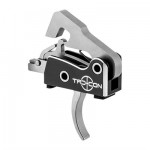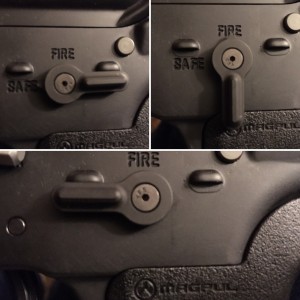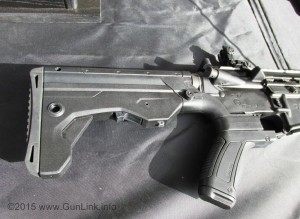Faux Automatic: Rapid Fire Without a Machine Gun
 Before heading to SHOT Show this year, I consulted with a few other female shooters that I know to ask what they were hoping to see new this year. In general, I was surprised to find that they were actually in the same KISS school of thought that I am: something that works well, works consistently, and is not difficult to understand how it works. One thing that did surprise me was more interest in fully automatic firearms than I had expected. I have been fortunate in that I have had the opportunity, on more than one occasion, to shoot automatic weapons. If you have not experienced full-auto mag dumps yourself, to be completely honest, it is even more fun than it looks.
Before heading to SHOT Show this year, I consulted with a few other female shooters that I know to ask what they were hoping to see new this year. In general, I was surprised to find that they were actually in the same KISS school of thought that I am: something that works well, works consistently, and is not difficult to understand how it works. One thing that did surprise me was more interest in fully automatic firearms than I had expected. I have been fortunate in that I have had the opportunity, on more than one occasion, to shoot automatic weapons. If you have not experienced full-auto mag dumps yourself, to be completely honest, it is even more fun than it looks.
Fully-automatic weapons, or machine guns, are regulated under the National Firearms Act (NFA). The law basically says that the only legal machine guns for civilians are the ones that were lawfully possessed prior to May 19, 1986 and those require payment of a $200 transfer tax, lengthy approval process, and federal registration in the NFRTR. This makes for a very limited supply of weapons that are in circulation, which – as we learned about supply and demand in Economics 101 – drives the price sky high – often into the tens or hundreds of thousands of dollars. Unless you either join the military or have some pretty cool friends, you may not get the opportunity to shoot a machine gun.
However, a shooter and their ammo (ergo, their money) are easily parted and the firearms industry has come up with some innovative ways to turn a pocket full of money into a hot, smoking pile of spent brass. Thanks to that innovation, there are some legal ways to simulate full-auto firing power.
Buried down in USC Title 26 Subtitle E Chapter 53 Subchapter B Part I, section 5845(b) of the NFA defines “machinegun” as “any weapon which shoots, is designed to shoot, or can be readily restored to shoot, automatically more than one shot, without manual reloading, by a single function of the trigger.” OK – overreaching lawmakers play their game of technicalities, nuances, and semantics; the firearms industry plays theirs.
One way to quickly burn through ammo is through a practice known as “bump-firing.” This works on firearms, mainly rifles, where the recoil is on the heavier side and it is necessary for the function of the rifle. The essential point is that the weapon is held in such a way that recoil from the rifle moves the firearm far enough to cause the trigger reset and then fire again when the trigger is pulled back forward onto the trigger finger. Each shot is fired as the result of a single trigger pull; the method simply facilitates very fast trigger pulls Done properly, this can be fast enough to simulate automatic fire. The plus side is that simple bump firing does not require any extra equipment or firearm modifications. However, due to the method of holding the firearm, shot placement is often not well controlled and allowing the firearm to flop around in different relation to each other than that for which they were designed can introduce malfunctions (think “limp wrist” malfunctions in pistols).
Although the concept and practice of bump-fire has been around for quite some time, more recent years have seen devices created that facilitate this method and help to make it a little less sloppy. The first of its kind was probably Bill Akins’ Akins Accelerator, the patent for which was applied for in the late ’90s and granted in 2000 and subsequently purchased by a company called FosTech.
Two companies currently dominate the market for devices that attach to your rifle to facilitate bump-fire action (a/k/a bumpstocks): Slide-Fire and FosTech. To say that Bill Akins’s invention has followed a rocky path would be accurate, and this market segment has been rife with legal turmoil ever since (Slide Fire makes bumpstocks, FosTech sues Slide Fire, Slide Fire gets patent allowance, Bump Fire Systems make bumpstocks, Slide Fire sues Bump Fire Systems, Bump Fire System disappears, and so on).
Slide-Fire makes a line of after-market stocks that are installed on your AR-15 or AK-47 style rifle (or Saiga), which take full advantage of the recoil impulse to allow the trigger to travel rearward enough from the trigger finger (which rests firmly on a shelf) to achieve full reset before being pulled back forward onto the trigger for follow-on shots. Slide Fire’s injection molded offerings start around $160 and range from the chunky original design to the new, more aesthetically pleasing and, arguably, more functional MOD version.
FosTech likewise makes bumpstocks for AK- and AR-style rifles called the Bumpski and DefendAR-15, respectively. These machined aluminum offerings function similarly, although prices start substantially higher around $450. This product works essentially the same the Slide-Fire, just a different design. When the stock is placed on the shoulder, the shooter leans into the rifle to help control the recoil, pushes forward with the supporting hand and applies constant pressure to the trigger. To the shooter, it seems like you only pull the trigger once. It takes some practice to resist the urge to man-handle the rifle, but it is worth the effort.
A letter from BATFE says that these stocks have “no automatic mechanical function” and the shooter “must apply constant forward pressure with the non shooting hand and constant rearward pressure with the shooting hand.” Taken together, this means that the stocks, when used on their respective rifles, do not constitute a machine gun and are not subject to NFA regulation.
Another way to get simulated full auto fire is through trigger upgrades. Recall from the earlier definition that a machine gun is a firearm that can fire “more than one shot, without manual reloading, by a single function of the trigger.” The key part here is “single function.” Recent innovative triggers have devised trigger mechanisms that help to not only increase a shooters rate of fire, but to allow shots to be more controlled and well aimed.
 Once such trigger is the Tac-Con 3MR (MSRP starts at $350) with “positive trigger reset.” These triggers operate normally in the first two firing positions: safe and a smooth, 4.5 pound semi mode. When the selector is moved to the third position, the positive reset feature is activated. According to Tac-Con, the positive reset “is achieved by transferring the force from the bolt carrier through the trigger assembly to assist the trigger back onto the front sear [and] gives the firearm the fastest reset possible.” While you still need a fast trigger finger and the Tac-Con only allows you to fire as fast as you can pull the trigger, it may help shooters pull the trigger faster than the would otherwise be able to.
Once such trigger is the Tac-Con 3MR (MSRP starts at $350) with “positive trigger reset.” These triggers operate normally in the first two firing positions: safe and a smooth, 4.5 pound semi mode. When the selector is moved to the third position, the positive reset feature is activated. According to Tac-Con, the positive reset “is achieved by transferring the force from the bolt carrier through the trigger assembly to assist the trigger back onto the front sear [and] gives the firearm the fastest reset possible.” While you still need a fast trigger finger and the Tac-Con only allows you to fire as fast as you can pull the trigger, it may help shooters pull the trigger faster than the would otherwise be able to.
If shooting as fast as you can pull the trigger still is not fast enough for you, two companies have come up with ways to double even that rate of fire. Once again, FosTech is in the fast fire arena with their Echo Trigger (MSRP $479). These triggers were designed to work in the AR-15 platform only. Per FosTech’s website, these are currently backordered until spring of 2017. The other company, Franklin Armory, has the Binary Firing System III (BFS; MSRP $430), The BFS works on most AR platforms, including AR-10 and AR-15. It also works on .22LR uppers and 9mm uppers, as well as in the Franklin Armory F17 series in .17 WSM. Per Franklin Armory’s website, there is currently an eight to twelve week wait period for new orders.
 Again, both systems operate normally in safe and semi-auto modes, with their special mode activated by moving the selector into the third position (either Echo Mode or Binary Mode). Regardless of the name, both modes function by causing the rifle to fire once when the trigger is pulled, and again when the trigger is released. They differ in how this is accomplished (and depending on whether it was before or after the ATF kicked it back to the drawing board), but they both they both effectively allow shooters to fire twice as fast as they can pull the trigger. Since each pull and each release action are separate, single functions of the trigger, and the second shot may be canceled by moving the selector back to position one or two with the trigger depressed, the ATF has ruled that neither constitute a machine gun when installed.
Again, both systems operate normally in safe and semi-auto modes, with their special mode activated by moving the selector into the third position (either Echo Mode or Binary Mode). Regardless of the name, both modes function by causing the rifle to fire once when the trigger is pulled, and again when the trigger is released. They differ in how this is accomplished (and depending on whether it was before or after the ATF kicked it back to the drawing board), but they both they both effectively allow shooters to fire twice as fast as they can pull the trigger. Since each pull and each release action are separate, single functions of the trigger, and the second shot may be canceled by moving the selector back to position one or two with the trigger depressed, the ATF has ruled that neither constitute a machine gun when installed.
Keep an eye on the GunLink site for an upcoming first-hand review of one of these systems, the Franklin Armory Binary Firing System BFS III!
There you have it. Several completely legal methods and after-market parts that will get you as close to fully-automatic fire as you can get without the hassle, waiting, and expense of the real thing. All retail for under $500, which is much cheaper than any machine gun you could find for sale.









